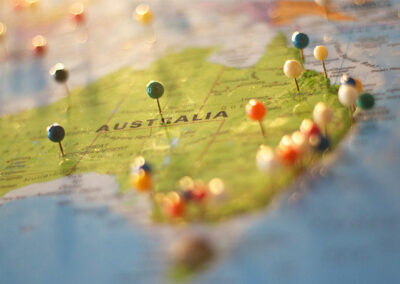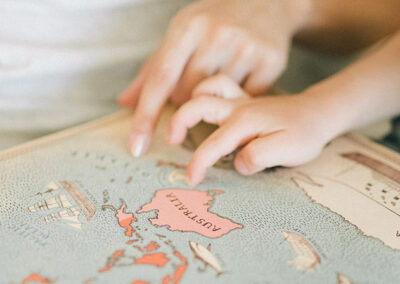
Whose Country: exploring First Nations peoples languages map (7-13yrs)
Time Allocation: 30 minutes
Activity Level: Easy
Introduction
This activity introduces children to a First Nations peoples languages map and builds an understanding and appreciation of the language and culture of local Aboriginal and Torres Strait Islander peoples.
Adam Shipp a Wiradjuri man shares the following:
“Language is a part of everything we do. It is in our country, our rocks, trees and landscapes. For Aboriginal and Torres Strait Islander people it is important for us to connect and reconnect to language of our ancestors and to speak this language every day. We believe our ancestors are always watching over us, so to speak our native tongue is to connect directly to them.”
Checklist
Instructions
 STEP 1
STEP 1
Begin this activity at your location with an Acknowledgement of Country. By acknowledging the Land, you are also making a promise that you will care for the land, the waterways, the plants and the animals.
Use the story to encourage the children to talk about their understanding of First Nations peoples languages. What did they learn from the story? What do they know about the languages of First Nations peoples? Have they heard anyone speak in these languages? Do they know some words for their local language group?
Listen and watch the Marin Gamu song where schools around Australia sing this song about body parts in their local language. Marrin’ and ‘Gamu’ mean ‘body’ in the Kalaw Kawaw Ya (Torres Strait) and Wiradjuri (NSW) languages.
Do you know any other songs about the body in language other than English? (example Head, Shoulders, Knees and Toes)
Not only are there many different First Nations communities across Australia there are a great diversity of languages and therefore diversity of cultures. These languages are complex and diverse as are the people.
Who could we ask to find out more about local language? Use this opportunity to invite local Aboriginal and Torres Strait Islander community members and people involved in language revitalisation work to help you explore First Nations Peoples’ culture and language for the people in your local area.
 STEP 2
STEP 2
Use the online Gambay First Languages Map to explain the significance of language. Tell the children that each language group had an important relationship with their Country and between Countries. No part of Australia was empty or without people. Language is important for identity.
Find the location of your setting on a map of Australia. Find that same location on the Gambay First Languages Map to find the name of the group where your school, youth group or home is located.
Use this Language Map to compare with a map of Australia showing the states and Territories.
How are they different? Compare the sizes of the groups? Why would they be different sizes? How would the groups differ across Australia? What role would the type of environment and climate play in where people live?
 STEP 3
STEP 3
Take some time outside to sit quietly and listen for 2 minutes. What do you hear – are there any sounds of animals or other natural environment sounds?
Explain safe and respectful behaviors and then give children the opportunity to explore for natural objects on the Country they are on. What can they find that makes them feel connected to place?
Discuss with the children what they have found on Country and how it makes them feel.
Discuss with the children how they might be able to look after the Country they are on. What other ideas do they have and what actions can they take? What can they do to show they feel thankful?
Discuss that an Acknowledgement of Country is way of saying what we are thankful for – we are thankful for the land, the water the plants, the animals, the people and looking after each other.
 STEP 4
STEP 4
Find your location on a map of Australia. Find that same location on the Language map to find the name of the group where you are located.
Use your research to add answers to the activity sheet.
Write an Acknowledgment of Country in the activity sheet. You can draw significant places, plants or animals for your Acknowledgment of Country.
Find the language groups for some of your favorite Australian locations on your sheet.
Explore some more local language uses with local Community Elders; use the online resources provided in the reference list to help you. Use the Welcome to Country App and search for your location on the map. Listen to a Welcome in the local language (if available).
Extension Activity
Extension 1
Find out the Country or language group for each of Australia’s capital cities.
Extension 2
Listen to the First Nations peoples language words from your location on the interactive 50 words map from the Research Unit For Indigenous language from the University of Melbourne and practice saying them.